
THE CONFUSION OF DIFFUSION
It's not often that an Indy Car driver wants to speed up his opponents, but those were Al Unser Jr.'s feelings at about 5:45 p.m. on Sunday. Most of the day he had been fretting in 51 st position in a line of 60 cars and drivers trying to qualify for the May 27 Indy 500, and now, with just 15 minutes left before the Indianapolis Motor Speedway was to close, there were still nine cars ahead of him. Unser could see that there was no way he would be able to make his run for the pole position unless time stopped and the action didn't, or the nine cars in front of his were fast-forwarded.
The squeeze was on because last Saturday's scheduled opening round of qualifying had been rained out, and the 2.5-mile Speedway was still soaked on Sunday. It wasn't until 4:34 p.m. that defending champion Emerson Fittipaldi, in a Penske-Chevy, became the first—and, as it would turn out, fastest—to qualify. As time ran out, he was sitting on the pole with a four-lap track record of 225.301 mph, and he will stay there at least until this Saturday, when qualifying resumes. At that time, everyone still in line to qualify Sunday will have his shot at the pole.
Unser and Fittipaldi are the same adversaries who attempted the impossible on the next-to-last lap of last year's 500. Stealing the breath from watching millions, they tried to drive through Turn 3 elbow-to-elbow at 200 mph. Fittipaldi pulled it off and drove into Victory Lane; Unser pulled himself out of his wrecked race car. That time, it had been fate and centrifugal force that favored Fittipaldi; on Sunday it was skill and the luck of the draw. Roger Penske, the owner of Fittipaldi's car, had drawn the No. 1 spot in the qualifying line for his man. Unser's owner, Rick Galles, had drawn No. 51.
Wind, rain or controversy had howled at the Brickyard for much of the week. In the first five days of practice there were six crashes—none of which caused serious injury—blamed at least in part on a new rule intended to make the cars safer. The finger-pointing centered on something called a diffuser, a carbon-fiber panel that had to be attached beneath the bodywork on pre-1990 model cars, of which there were 31 at the Speedway. Its function is to slow the cars by reducing the downforce that causes an Indy racer to hug the track; the 29 '90 cars were not required to have diffusers because they were built to the supposedly slower '90 specs. But some of the teams with older cars complained that the diffusers made their cars unstable as well as slow. After last Wednesday's practice, eight car owners and 12 drivers met with officials of the United States Auto Club (USAC), which sanctions the 500, and asked to be allowed to remove the diffusers. The request was denied on the grounds that other owners of pre-'90 cars had solved the stability problem and were comfortable with their cars' handling.
Eddie Cheever, the American Formula One veteran who has returned home to race Indy Cars, was in a 1989 Penske-Chevy similar to the car in which Fittipaldi won last year. As drivers of '90 cars were surpassing 220 mph with ease, he remarked, "Jesus Christ himself couldn't reach 220 in one of these cars with diffusers." He was informed that Rick Mears had tested the diffusers for USAC and had topped 220 with no problem. Cheever paused and replied, "I said Jesus Christ couldn't reach 220, not Rick Mears."
If Sunday's qualifying proved anything, it might have been that Mears, a three-time winner of the 500, isn't omnipotent on an oval track. After setting track records and claiming the pole the past two years, on this day he could not match Fittipaldi, who joined the Penske team between seasons. Fittipaldi, a two-time Formula One world champion, had said, "I'm so happy to be working with Rick because I'm learning so much from him." Mears might now wish that Fittipaldi hadn't been so attentive.
At the conclusion of practice last Friday afternoon, the three contenders for the pole figured to be Unser, with the week's best lap of 228.502 mph, then Fittipaldi, at 227.181, and Mears, at 226.655. But Mears had been frustrated late Friday afternoon; he had had an absolute screamer of a lap going in his Penske-Chevy—he thinks it might have been a 229—when the yellow light came on because of debris on the track, forcing him to abort his run. There was time for another try, but Mears decided to pass. "When I get that mad I always park it, rather than doing something crazy," said Mears, who knows that the key to survival is self-control as well as car control.
Mears was sixth in the qualifying order on Sunday. He came onto the track believing that Fittipaldi's 225.301 would fall. But Mears's opinion changed on the first lap, when his supersensitive tailbone told him his car's setup was about half a notch shy of perfection. "We're on such a fine line at these speeds that if you miss it by this much," he said, holding his thumb and index finger about 1/16" apart, "you've lost one mile per hour." Which is exactly what happened; he ended up second-fastest at 224.215 mph. The front row was filled out by Bobby Rahal at 222.694 in a Lola-Chevy. When Michael Andretti, also in a Lola-Chevy, qualified at 222.055, he finished a family sweep of the second row, which he shared with his father Mario (222.025 in another Lola-Chevy) and his cousin John (219.484 in a March-Porsche).
Waiting a week for a shot at the pole will place a burden on Unser and his team. An Indy Car is prepared one way for qualifying and another way for the race, so Fittipaldi's and Mears's crews can work on their race setups, while Unser's will be spending precious time trying to squeeze out more qualifying speed. The team probably wouldn't bother were it not for the $100,000 that goes to the pole winner, and the publicity and marketing value that accrue to his team. "It I was Emmo right now, I'd feel pretty good," said Unser. And, indeed, the cool, overcast conditions of Sunday afternoon had been nearly ideal for qualifying; who could tell what Saturday might bring?
At the end of the day, all Unser could do was compose a message, instructing that it be delivered with a challenging grin to his Indy nemesis. The message read: "At least you're going to have to sweat it out for a week, Emerson."
TWO PHOTOS
AP PHOTO
Jim Crawford's car, equipped with a diffuser, went airborne, but Crawford landed safely.
PHOTO
GEORGE TIEDEMANN
Fittipaldi used the No. 1 qualifying slot to get No. 1 on the starting grid—at least for now.
PHOTO
LARRY HOSTETLER PHOTOS
Johnny Rutherford's car was one of the '89s that took a wrong turn.

